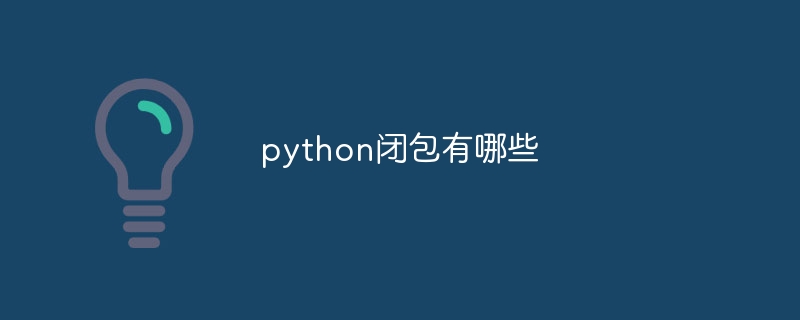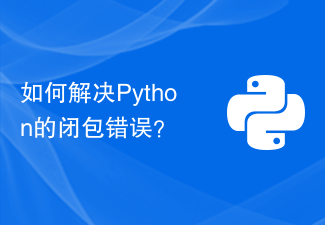 Web Front-end
Web Front-end JS Tutorial
JS Tutorial The key to building efficient, maintainable JavaScript applications: understanding the five key elements of closures
The key to building efficient, maintainable JavaScript applications: understanding the five key elements of closures
Five elements of closure: the key to building efficient and maintainable JavaScript applications, requiring specific code examples
Introduction:
With the rapid development of web applications With the development of JavaScript, it has become one of the most important languages in front-end development. Among them, closure is a very important concept and one of the key elements in building efficient and maintainable JavaScript applications. By using closures, we can implement code encapsulation, variable protection and module division. This article will introduce the five elements of closures and illustrate their usage and functions through specific code examples.
1. What is closure?
In JavaScript, a closure refers to a function defined inside a function, and this internal function can access the variables of the external function. In other words, a closure is a function that contains access to external function variables. By using closures, we can capture the variables of the outer function and save them in the inner function, allowing us to access these variables outside the function.
2. Five elements of closure
- Internal function definition: The first element of closure is to define a new function inside a function. This new function will be called the inner function and it will have access to all the variables and parameters of the outer function.
The following is a simple example:
function outer() {
var x = 10;
// 定义内部函数
function inner() {
console.log(x);
}
// 返回内部函数
return inner;
}
// 创建闭包
var closure = outer();
// 调用闭包
closure(); // 输出 10In the above code, an inner function inner is defined inside the outer function, and the inner function can access the variable x of the outer function.
- External function call: The second element is the call of external function. When we call the outer function, it returns a reference to the inner function. In this way, we create a closure.
In the above example, we created a closure by calling the outer function and assigned it to a variable. We can access the variable x in the outer function by calling this closure.
- The reference of the closure: The third element of the closure is to save the reference of the closure in a variable. By saving a reference to the closure, we can call the closure outside the function and access the variables of the outer function.
In the above example, we save the reference to the closure in the variable closure, and access the closure by calling this variable.
- Destruction of the external function environment: The fourth element of closure is the destruction of the external function environment. When the external function completes execution, its internal function can still access the variables of the external function. This is because the closure stores references to the variables of the external function so that the environment of the external function will not be destroyed.
In practical applications, this element allows us to use closures to implement some special functions, such as saving the state of a certain variable in some callback functions.
- Unbinding of external function variables and internal function references: The last element of the closure is the unbinding of external function variables and internal function references. When we create a closure, the variables of the external function will not be destroyed until all references to the closure are released.
This element is very important in practical applications, because without a suitable unbinding mechanism, the variables of the external function will always exist in the memory after the function is executed, causing memory leaks.
3. The role and application scenarios of closures
Closures are widely used in JavaScript. The following are several common application scenarios:
- Private variables and function implementation: By using closures, we can create private variables and functions inside the function to prevent external access and modification.
function counter() {
var count = 0;
return function() {
count++;
console.log(count);
};
}
var c = counter();
c(); // 输出 1
c(); // 输出 2In the above example, the count variable is private and can only be accessed and modified through the closure c.
- Function memory: By using closures, we can save the results of the function in the cache. When the function with the same parameters is called again, the results in the cache are directly returned, thereby improving the execution efficiency of the function. .
function memoize(f) {
var cache = {};
return function() {
var key = JSON.stringify(arguments);
if (cache[key]) {
return cache[key];
} else {
var result = f.apply(null, arguments);
cache[key] = result;
return result;
}
};
}The above code is a simple example of the memoize function, which caches the incoming function results to avoid repeated calculations.
4. Conclusion
Closures are one of the key elements in building efficient and maintainable JavaScript applications. By using closures, we can encapsulate and protect variables, and divide and reuse modules. In practical applications, we need to understand the concept and usage of closures, and pay attention to some problems that closures may cause, such as memory leaks. At the same time, by properly applying closures, we can improve the readability, maintainability and execution efficiency of the code.
The above is the detailed content of The key to building efficient, maintainable JavaScript applications: understanding the five key elements of closures. For more information, please follow other related articles on the PHP Chinese website!
 一文浅析Golang中的闭包Nov 21, 2022 pm 08:36 PM
一文浅析Golang中的闭包Nov 21, 2022 pm 08:36 PM闭包(closure)是一个函数以及其捆绑的周边环境状态(lexical environment,词法环境)的引用的组合。 换而言之,闭包让开发者可以从内部函数访问外部函数的作用域。 闭包会随着函数的创建而被同时创建。
 python闭包有哪些Oct 30, 2023 pm 04:53 PM
python闭包有哪些Oct 30, 2023 pm 04:53 PMpython闭包主要包括函数闭包和装饰器闭包。详细介绍:1、函数闭包是指在一个函数内部返回另一个函数,并且返回的函数能够访问到其内部变量。这样的返回函数就是函数闭包,函数闭包在程序中可以被反复使用,因此可以用来实现一些功能上的封装;2、装饰器闭包是指在使用装饰器时,被装饰的函数并没有直接被调用,而是被包装在一个函数内部,并返回一个新的函数。这个新的函数就是一个装饰器闭包等等。
 如何利用PHP7的匿名函数和闭包实现更加灵活的代码逻辑处理?Oct 21, 2023 am 10:21 AM
如何利用PHP7的匿名函数和闭包实现更加灵活的代码逻辑处理?Oct 21, 2023 am 10:21 AM如何利用PHP7的匿名函数和闭包实现更加灵活的代码逻辑处理?在PHP7之前,我们经常使用函数来封装一段特定的逻辑,然后在代码中调用这些函数来实现特定的功能。然而,有时候我们可能需要在代码中定义一些临时的逻辑块,这些逻辑块没有必要创建一个独立的函数,同时又不想在代码中引入太多的全局变量。PHP7引入了匿名函数和闭包,可以很好地解决这个问题。匿名函数是一种没有名
 Python中的闭包是如何实现的?Oct 21, 2023 am 10:33 AM
Python中的闭包是如何实现的?Oct 21, 2023 am 10:33 AMPython中的闭包是如何实现的?闭包是一种函数内部定义的函数,并且在函数内部引用了外部函数的变量。这种特性使得内部函数可以访问外部函数的变量,并且在外部函数执行完毕后,闭包仍然可以访问和操作外部函数的变量。闭包在Python中通过以下几个步骤来实现:定义外部函数,并在其中定义内部函数:首先,我们需要在外部函数内部定义一个内部函数。这个内部函数即是闭包。de
 react有哪些闭包Oct 27, 2023 pm 03:11 PM
react有哪些闭包Oct 27, 2023 pm 03:11 PMreact有事件处理函数、useEffect和useCallback、高阶组件等等闭包。详细介绍:1、事件处理函数闭包:在React中,当我们在组件中定义一个事件处理函数时,该函数会形成一个闭包,可以访问组件作用域内的状态和属性。这样可以在事件处理函数中使用组件的状态和属性,实现交互逻辑;2、useEffect和useCallback中的闭包等等。
 怎么样减少闭包的产生Oct 27, 2023 pm 04:28 PM
怎么样减少闭包的产生Oct 27, 2023 pm 04:28 PM减少闭包产生的方法有避免不必要的闭包、控制闭包的返回值、使用弱引用、减少不必要的全局变量、合理使用循环和递归、使用事件代理、编写单元测试、遵循设计原则和使用工具进行代码分析等。详细介绍:1、避免不必要的闭包,在很多情况下,闭包并非必需的,可以用模块模式来实现私有变量,避免使用闭包;2、控制闭包的返回值,在使用闭包时,应该尽量控制闭包的返回值,如果闭包返回的是基本数据类型等等。
 如何使用PHP7的匿名函数和闭包实现更加灵活和可复用的代码逻辑?Oct 24, 2023 am 10:30 AM
如何使用PHP7的匿名函数和闭包实现更加灵活和可复用的代码逻辑?Oct 24, 2023 am 10:30 AM如何使用PHP7的匿名函数和闭包实现更加灵活和可复用的代码逻辑?在PHP编程领域中,匿名函数和闭包是非常有价值和强大的工具。PHP7引入了一些新的语言特性,使得使用匿名函数和闭包更加方便和灵活。本文将介绍如何使用PHP7的匿名函数和闭包来实现更加灵活和可复用的代码逻辑,并提供一些具体的代码示例。一、匿名函数匿名函数是一种没有名称的函数。在PHP中,可以将匿名
 如何解决Python的闭包错误?Jun 24, 2023 pm 11:23 PM
如何解决Python的闭包错误?Jun 24, 2023 pm 11:23 PMPython是一种非常流行的编程语言,因为它非常易学易用,同时也具备了强大的功能。其中,闭包是Python中的一种函数,它可以在函数的内部定义另一个函数,并返回这个函数作为函数的返回值。尽管闭包非常方便,但有时会出现某些错误,比如闭包错误。本文将介绍如何解决Python的闭包错误。初步了解闭包在Python中,闭包是由一个内部函数和一个定义在内部函数之外的函


Hot AI Tools

Undresser.AI Undress
AI-powered app for creating realistic nude photos

AI Clothes Remover
Online AI tool for removing clothes from photos.

Undress AI Tool
Undress images for free

Clothoff.io
AI clothes remover

AI Hentai Generator
Generate AI Hentai for free.

Hot Article

Hot Tools

WebStorm Mac version
Useful JavaScript development tools

SublimeText3 Mac version
God-level code editing software (SublimeText3)

SublimeText3 Chinese version
Chinese version, very easy to use

Safe Exam Browser
Safe Exam Browser is a secure browser environment for taking online exams securely. This software turns any computer into a secure workstation. It controls access to any utility and prevents students from using unauthorized resources.

Dreamweaver Mac version
Visual web development tools





